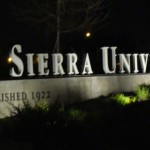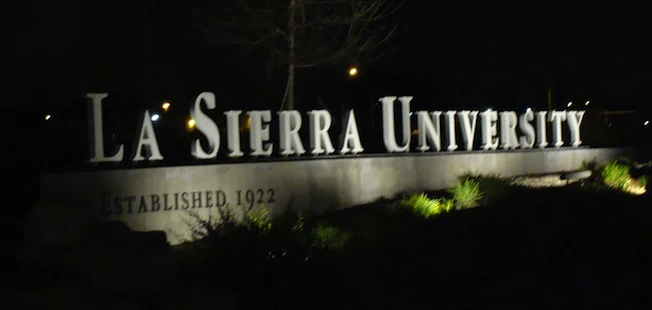 Sometimes you don't want a story to be confirmed. Sometimes you desperately want it not to be true. Unfortunately, the story about La Sierra's use of tax-exempt municipal bond money has been confirmed in its essential details by the university's official press release.
Not only does Larry Becker confirm the Price Science Complex was re-financed with public bond money, he also confirms the balance of the bond money. Some $7 to $8 million has been used for capital improvement projects around the university.
Sometimes you don't want a story to be confirmed. Sometimes you desperately want it not to be true. Unfortunately, the story about La Sierra's use of tax-exempt municipal bond money has been confirmed in its essential details by the university's official press release.
Not only does Larry Becker confirm the Price Science Complex was re-financed with public bond money, he also confirms the balance of the bond money. Some $7 to $8 million has been used for capital improvement projects around the university.
Of greatest importance, however, is that the university does not deny that the bonds contain the following restrictive language:
The Corporation covenants and agrees that no portion of the proceeds of the Bonds will be used to finance or refinance any facility, place or building used or to be used for sectarian instruction or study or as a place for devotional activities or religious worship or in connection with any part of the programs of any school or department of divinity,” (page D-32) and that these restrictions apply “for the duration of the useful life of the project financed with the proceeds of the Bonds. (page 27)
Of course, it would be pointless to try to deny this, because the bonds are public documents and are posted online.
Given the prohibited covenant language, not only has the Thaine B. Price Science Complex been secularized in perpetuity, every building on campus on which the remaining $8 million has been spent, has also been secularized in perpetuity.
Unfortunately, the university's primary outside counsel, Kent Hansen, makes misleading arguments in the press release. First, he implies that the California Supreme Court's language in the case of California Statewide Community Development Authority v. All Persons Interested in Matter of the Validity of Purchase Agreement (2007) 40 Cal.4th 788; 152 P.3d 1070, is the language that governs the bonds. In a way it does, but it only sets the minimum standards that entities receiving public money in California must abide by. The covenant language demanded by the bond authority and placed in the documents that Wisbey and Geriguis signed is the language that immediately governs these bond moneys, and restricts the use of buildings on which these moneys have been spent.
By way of analogy, suppose there is a city ordinance requiring that all houses be set back 30 feet from the street, but the lot that you purchased and wish to build your house on contains a restrictive covenant that requires you to set your house back at least 45 feet from the street. If you try to build your house 30 feet from the street, the other lot owners can sue to enforce the covenant, and force you to move it back 15 feet. And they'll win, because that's what you agreed to, as evidenced by the documents that you signed with due solemnity. It doesn't matter that the city only requires you to set back 30 feet, you agreed to set back 45 feet, and if you build your house closer than that, it's liable to be bulldozed.
So what directly governs the use of the money from these bonds is not the Supreme Court's minimum standard, but what La Sierra agreed to, what Wisbey and Geriguis signed, and what they agreed to is the covenant language referred to in all the articles. There is no indication in the bond document that this covenant is unenforceable. To the contrary, the failure to abide by the covenant, if left uncorrected for more than 30 days, is an “event of default” pursuant to provision (a)(iii) on page D-32 of the bond, and one of the remedies in the event of default, as describe on page D-33 (a)(iii), is that the University can be sued and forced to abide by the covenant.
But even if Hansen were correct in his implication that what governs is not the contractual language the University agreed to but rather the California Supreme Court's decision, Hansen does not properly appreciate the implications of that ruling. The portion of the opinion Hansen selectively quotes from is as follows:
[T]he straightforward assessment for the trial court to make is whether the academic content of a religious school's course in a secular subject such as math, chemistry, or Shakespeare's writings is typical of that provided in nonreligious schools. When a school establishes, through its course descriptions or otherwise, that the academic content of its secular classes is typical of comparable courses at public or other nonreligious schools, it is not necessary to scrutinize the school's day-to-day classroom communications. The circumstance that a teacher may, in addition to teaching a course's religiously neutral content, express an idea or viewpoint that may be characterized as 'religious' does not result in a benefit to religion that is more than incidental to the state's primary purpose of enhancing secular education opportunities for California residents. (20 Cal.4th at 804-805; 152 P.3d at 1080.)
Assuming that La Sierra wanted to teach creation science, or the Seventh-day Adventist view of origins, in the Price Science Complex, it could not do so under this standard. The class offering would not be “typical of that provided in nonreligious schools” nor would the course content be “typical of comparable courses at public or other nonreligious schools.” It would be uniquely biblical and Seventh-day Adventist, and utterly atypical of anything taught in public or nonreligious schools.
So even the California Supreme Court's operative language would certainly prohibit teaching creation science, intelligent design, or flood geology in any systematic way. At most, the professor would be limited to expressing the occasional religious idea or viewpoint; he could not teach the Seventh-day Adventist view of origins in a systematic or comprehensive way. This should be obvious to any layman reading the opinion, and for Kent Hansen, who holds himself out as a lawyer, to imply otherwise is legal malpractice. In all likelihood, even beginning class with a devotional thought and a prayer will not pass constitutional muster under this California decision, and obviously runs afoul of the agreed covenantal language prohibiting “devotional activities or religious worship.”
Hansen notes that other religious institutions have received public bond money, including Azusa Pacific, Biola, Mater Dei High School, and Westmont University. This argument is familiar to every parent: “but, mom, everyone else is doing it!!” to which the time-honored reply is, “if everyone else was jumping off a cliff, would you jump off a cliff?” We are unfamiliar with the bond terms negotiated by the other institutions mentioned, but the terms Hansen negotiated for La Sierra University, and allowed his client to sign and commit to, are unacceptable.
The remainder of the university's press release is devoted to shifting blame onto the board of trustees, but nowhere does the press release state that the full board of trustees was apprised of the language of the prohibited use covenant. Ricardo Graham is quoted as saying that the bond measure passed through channels, and of course it did, but he does not say that he was aware, at the time, that the bond document contained the restrictive language. I wonder how many of the trustees will soon be coming forward denying that they were ever apprised of this issue.

